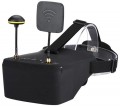The viewing angle provided by virtual reality glasses is the angular size of the space that falls into the user's field of view. Usually, the characteristics indicate the size of this space horizontally; however, if you need the most accurate information, this point needs to be specified separately.
The wider the viewing angle — the more the game space the user can see without turning his head, the more powerful the immersion effect and the less likely that the image will be subject to the "tunnel vision" effect. On the other hand, making the field of view too wide also does not make sense, given the characteristics of the human eye. In general, a
large viewing angle is considered to be an angle of 100° or more. On the other hand, there are models where this indicator is 30° or even less — these are, usually, specific devices (for example, drone piloting glasses and augmented reality glasses), where such characteristics are quite justified given the overall functionality.
The presence in the glasses of the connector type
USB-C. This is a relatively new type of USB port, which has a miniature size (slightly larger than microUSB) and a convenient double-sided design that allows you to connect the plug in either direction. It can be found in glasses for various purposes and, accordingly, provide different ways of application. So, in models for PC / consoles, this connector is used similarly to traditional USB — with the main connection, in parallel with the HDMI or DisplayPort video interface. In standalone devices, on the other hand, USB-C is mainly used to charge the battery and connect to a computer for direct file exchange, settings management, firmware updates, etc.
Also note that this paragraph may specify the USB version, which corresponds to the USB-C connector. Nowadays, two versions are relevant — 3.2 gen 1 and 3.2 gen 2; for VR glasses, the difference between them is generally not fundamental.

